How to Navigate Hiring During the Great Regret
Over the last couple of years, the labor market has fluctuated drastically, and every industry is feeling that rollercoaster ride, including the indoor agriculture industry. It’s tough trying to find quality candidates that are willing to make the jump to a new organization. While not too long ago it seemed as if everyone was jumping ship from their current employer, however, many contributing factors are now causing job seekers to be more cautious.
The Great Regret
According to the Bureau of Labor Statistics, a new quit rate record was made in November and December 2021, rising to 3%, in what has been called the Great Resignation. Just like any trend, the great resignation has ended. However, now it has taken a turn. New studies show that those who have acted impulsively to quit their jobs are now regretting their decision, about 1 and 4 people who have quit their job in the last year have regrets. While over 40% of those who left for a new opportunity say their new job is not living up to their expectations.
These candidates may have learned to take their time when considering quitting their job, and now are being extra cautious. Since many candidates have just left a job, they’re not likely ready to leave another, which is going to make the talent pool smaller. They are also going to take their time finding a new job that checks all their boxes. While, hopefully, they’ve learned to consider all the possibilities when it comes to finding a new job, it does slow down the hiring process.
Bystanders of the Great Resignation
Those employees that did not participate in the Great Resignation, watched their coworkers, friends, and family quit their jobs. Many of them may have been envious but didn’t want to take the plunge. However, now they are watching them regret their decisions. This is causing these candidates to approach a new opportunity with caution. They don’t want to take a leap and regret their choice. They feel safer staying put.
Recession Concerns
The looming recession is also causing candidates to hesitate. While we may have hoped the economy would have leveled out after 2 years of disruption due to the Covid-19 pandemic, other factors have dashed those hopes. While experts are divided on the probability, many people have concerns that a recession is in our immediate future.
With the possibility looming, candidates are not going to act impulsively. Instead, they are going to carefully weigh the risks and rewards of changing jobs. They will consider if the agribusiness or indoor farm will be a stable opportunity. Is there a possibility of layoffs, could the company close, or will they still have an income if the recession comes? Is the company culture a better fit than where they are currently employed? Is there a pay increase and is it worth the risk?
How to Hire During the Great Regret
With so much hesitation from candidates, it’s making it difficult to find quality candidates in the controlled environment agriculture industry. In today’s job market, finding candidates for your open positions feels like an uphill battle. We’re finding that job seekers are applying to roles but are taking extra caution with which role they will move forward with. So, how can you fill your current openings when everyone is afraid to move?
Train the Right Person
If it’s a struggle to find candidates willing to take the leap for a new job consider hiring outside of the industry or hiring more junior employees, and spend some extra time training. Ensuring that your training is efficient and effective will allow you to bring new hires up to speed quickly and keep your agribusiness or indoor farm competitive in the market.
Also, look within your current team and promote from within. You might already have the right person for the job with some extra training. Training is sharing knowledge and teaching employees to perform their best. It may seem daunting, but it doesn’t have to be complicated.
Look for Inherent Traits
Remember, it’s not always what is on the resume that is important. Yes, you want your employees to have the skills and know-how to do a job, but you also want a candidate that fits your company’s culture. Their resume doesn’t show you what their work ethic is like or if their personality will mesh well with your team.
Finding the right people with the right attitude can make all the difference in your hiring strategy. In ag, we want candidates that have a strong work ethic, are passionate about their work and have the energy and enthusiasm required to do the job. Other industries also attract those candidates, such as the military and construction industry. They also have skills that can easily translate into the agriculture industry.
It’s All About Your Culture
Your organization’s culture is ultimately what will attract quality candidates to your indoor farm or agribusiness. Today’s candidates want to know what it’s like to work with your team on a daily basis and if will they fit in with the environment. Filling your team with employees that have similar values, behaviors, and communication styles will help your team and indoor ag business be successful.
Showcase your culture in your job descriptions and during interviews. Don’t just tell them what it’s like to work at the organization but give them examples, so they can gauge for themselves. Use the language in your job descriptions to attract the type of candidates you want. Avoid buzzwords that have lost their meaning, like “we’re a family” or “fast-paced environment”. Instead, use real examples from your indoor farm or agribusiness to showcase your culture. Adding something like, “Sundays off to encourage a healthy work-life balance” or “company events to encourage comradery.” Mentioning certain benefits such as “paid paternity time off for expectant mothers and/or fathers” is a great idea to show what you’re all about.
Go beyond just the compensation and insurance benefits. Do you offer opportunities for continuous learning? Do you have a rewards program or offer bonuses? Do you go beyond the industry standard with any of your benefits? Do you offer any flexibility in the off-season? Any range of benefits showcases how an organization treats its employees.
Conclusion
It’s a challenging time to hire agricultural candidates with so many factors for them to consider. While it can be challenging, there are ways to work through the obstacles and find quality employees to fill your team. It will take more work to publicize your job openings and reach out to candidates to attract them to your indoor farm or agribusiness.
Hiring can be tough, but AgHires is here to help you attract and find THE hire for your vertical farming and controlled environment agriculture organization. We are an industry-leading ag recruitment agency and job advertising company. We have an extensive network to help with everything from job advertising to full-service recruiting for your ag professional level and executive level positions. Contact us today to get started showcasing your indoor ag business.
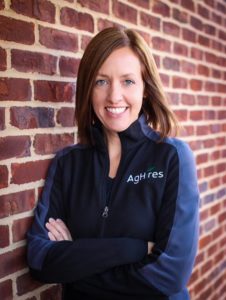 Special thanks to Lori Culler for this post.
Special thanks to Lori Culler for this post.
Indoor Ag-Con 2023 speaker Lori (Lennard) Culler is the founder of AgHires, an online job board and recruiting firm dedicated to the Agriculture, Horticulture, and Food Production industry. AgHires offers job advertising, candidate sourcing, and full-service recruitment solutions for farms and agribusinesses across the U.S. and Canada. Lori grew up on her family’s 3rd generation potato, tomato, and grain farm operating today across four states. After graduating from the University of Toledo with a bachelor’s degree in Human Resource Management, she began working in human resources in both recruiting and management consulting. While hiring for her family’s operation, she quickly realized the lack of resources in the industry to find and attract talent which inspired her to launch AgHires.
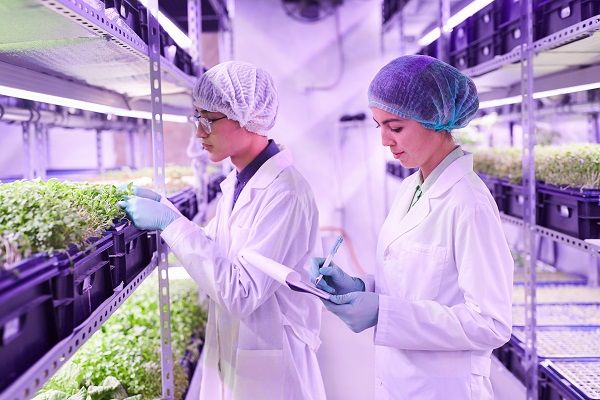

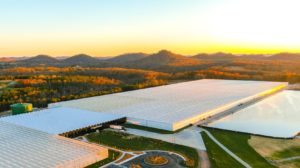 Kentucky is my home state and I do love it. But, it also makes sense strategically to build an AgTech hub in Central Appalachia for a few reasons:
Kentucky is my home state and I do love it. But, it also makes sense strategically to build an AgTech hub in Central Appalachia for a few reasons: Change begins with education. We recognized the need for a consumer movement to encourage folks to learn where their food comes from and understand that their purchases matter. The Fight the Food Fight campaign is a call to action that asks consumers to join us in creating a more resilient food system designed for the long-term wellbeing of people and planet by supporting products that promote sustainable farm operations and good, living-wage jobs in agriculture.
Change begins with education. We recognized the need for a consumer movement to encourage folks to learn where their food comes from and understand that their purchases matter. The Fight the Food Fight campaign is a call to action that asks consumers to join us in creating a more resilient food system designed for the long-term wellbeing of people and planet by supporting products that promote sustainable farm operations and good, living-wage jobs in agriculture.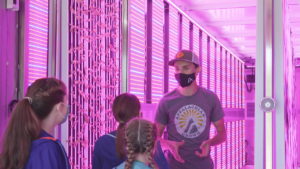 As we work to build a hub of sustainable agriculture in Central Appalachia, we know we need to create an AgTech ecosystem with good education at all levels. That’s why we are investing in the next generation of farmers and futurists by supporting high school AgTech education. We have launched seven container farms since the start of our program, with a goal to have 20 across Central Appalachia to serve as a model across the U.S.
As we work to build a hub of sustainable agriculture in Central Appalachia, we know we need to create an AgTech ecosystem with good education at all levels. That’s why we are investing in the next generation of farmers and futurists by supporting high school AgTech education. We have launched seven container farms since the start of our program, with a goal to have 20 across Central Appalachia to serve as a model across the U.S.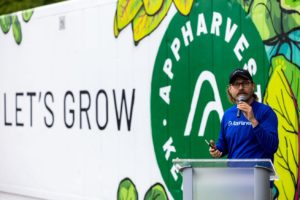 These free-standing training facilities are made from shipping containers retrofitted with the latest sustainable agriculture technology, including energy-efficient LED grow lights and a closed-loop irrigation system that teaches students how to use up to 90% less water and grow up to 30 times more food in the same amount of space compared to traditional open-field agriculture. One container farm classroom can produce the equivalent of three to five acres of traditional agriculture, and the technology in each unit is a good example of what AppHarvest employees use every day on a larger scale.
These free-standing training facilities are made from shipping containers retrofitted with the latest sustainable agriculture technology, including energy-efficient LED grow lights and a closed-loop irrigation system that teaches students how to use up to 90% less water and grow up to 30 times more food in the same amount of space compared to traditional open-field agriculture. One container farm classroom can produce the equivalent of three to five acres of traditional agriculture, and the technology in each unit is a good example of what AppHarvest employees use every day on a larger scale.

 Driever went on to detail how TAC has operated a 3,000 square foot greenhouse and 1,000 square foot grow room raising leafy greens for the past 10 years.
Driever went on to detail how TAC has operated a 3,000 square foot greenhouse and 1,000 square foot grow room raising leafy greens for the past 10 years. Launched in 2018, the indoor farm has approximately 6,000 square feet of space and capacity for 26,000 plants. The farm raises lettuce, kale, basil microgreens, amaranth, green and purple shiso, wasabi, cilantro and mint. Twelve full and part-time employees work at the indoor farm. They monitor the pumps, which dispense nutrients as they are needed. They transfer plants from germination to seedling stage and later to the area where plants grow to their desired size and are harvested. We have a great opportunity to explore agricultural sustainability and we’ve got a great opportunity to create jobs for people with disabilities. Arnold Farms uses no pesticides, and the founder Craig Varterian likes to call the facilities plants ‘purer than organic’. What’s Varterian’s dream for the future of Arnold Farms? He’d like to employ this kind of farming around the country, especially in ‘food deserts’ where food isn’t easily accessible. “I’d like to see people with disabilities as leaders around the country in this type of farming,” he adds. More information is available
Launched in 2018, the indoor farm has approximately 6,000 square feet of space and capacity for 26,000 plants. The farm raises lettuce, kale, basil microgreens, amaranth, green and purple shiso, wasabi, cilantro and mint. Twelve full and part-time employees work at the indoor farm. They monitor the pumps, which dispense nutrients as they are needed. They transfer plants from germination to seedling stage and later to the area where plants grow to their desired size and are harvested. We have a great opportunity to explore agricultural sustainability and we’ve got a great opportunity to create jobs for people with disabilities. Arnold Farms uses no pesticides, and the founder Craig Varterian likes to call the facilities plants ‘purer than organic’. What’s Varterian’s dream for the future of Arnold Farms? He’d like to employ this kind of farming around the country, especially in ‘food deserts’ where food isn’t easily accessible. “I’d like to see people with disabilities as leaders around the country in this type of farming,” he adds. More information is available  Founded in 1961, DDI is a dynamic, non-profit agency with more than 30 locations throughout Long Island, NY. It provides special education, vocational , day and residential programs, as well as healthcare services for more than 5,000 children and adults with autism and other developmental disabilities. The Horticulture curriculum of DDI offers greenhouse opportunities to more than 300 adults served in Adult Day Services. The greenhouse has been in operation for more than 30 years. Some of the vegetables include peppers, lettuce, tomatoes, squash, kale and various herbs to name a few. The greenhouse offers 1,500 square feet of growing space. This enables the DDI team to grow vegetables indoors during the colder weather. Vegetables grown are either sold at farmers markets or used at various site for cooking classes. More information is available
Founded in 1961, DDI is a dynamic, non-profit agency with more than 30 locations throughout Long Island, NY. It provides special education, vocational , day and residential programs, as well as healthcare services for more than 5,000 children and adults with autism and other developmental disabilities. The Horticulture curriculum of DDI offers greenhouse opportunities to more than 300 adults served in Adult Day Services. The greenhouse has been in operation for more than 30 years. Some of the vegetables include peppers, lettuce, tomatoes, squash, kale and various herbs to name a few. The greenhouse offers 1,500 square feet of growing space. This enables the DDI team to grow vegetables indoors during the colder weather. Vegetables grown are either sold at farmers markets or used at various site for cooking classes. More information is available  Greens Do Good raises microgreens, basil and butterhead lettuce hydroponically in Hoboken, New Jersey. They donate 100% of their proceeds to REED Next, a nonprofit organization supporting adults with autism. This helps provide continued education, life experience, and work opportunities so that these individuals can achieve greater independence and participate meaningfully in their communities. Greens Do Good also provides these individuals the opportunity to work at our farm. Our focus is on providing local businesses with top-quality, locally grown ingredients year-round. We hand-pick and pack our produce at the height of freshness and deliver them straight to our customer’s door for peak taste and nutrition. In the future, we hope to open more farms with the goal of expanding and continuing to create sustainable funding for REED Next. More information about our work is available
Greens Do Good raises microgreens, basil and butterhead lettuce hydroponically in Hoboken, New Jersey. They donate 100% of their proceeds to REED Next, a nonprofit organization supporting adults with autism. This helps provide continued education, life experience, and work opportunities so that these individuals can achieve greater independence and participate meaningfully in their communities. Greens Do Good also provides these individuals the opportunity to work at our farm. Our focus is on providing local businesses with top-quality, locally grown ingredients year-round. We hand-pick and pack our produce at the height of freshness and deliver them straight to our customer’s door for peak taste and nutrition. In the future, we hope to open more farms with the goal of expanding and continuing to create sustainable funding for REED Next. More information about our work is available  Lettuce Dream is a social enterprise engaged in hydroponic farming that exists to provide meaningful employment and job training programs for persons with cognitive or developmental disabilities so that they may enjoy the benefits of living, working and fully participating in our community. Lettuce Dream was founded in 2016 and operates a 6700 square foot hydroponic greenhouse. Lettuce Dream helps to provide workplace skill training for young adults with intellectual disabilities. The people with disabilities in Lettuce Dream’s program take part in an internship alongside volunteers from the community, staff and their college peers from Northwest Missouri State University growing 500-700 lbs of leafy greens and living basil per week. The interns in the program help with all aspects of Lettuce Dream’s business operations including- seeding, transplant, packaging, food safety recordkeeping, data entry, invoicing and customer service. After obtaining the necessary pre-vocational skills and developing their resumes through the internship program, Lettuce Dream helps the interns transition to community employment. Lettuce Dream helps the individuals in the program secure jobs and provides further on the job support through job coaching. Since their founding, Lettuce Dream has helped provide employment supports for 24 people with disabilities and has an 83% placement rate for individuals that have completed the program. More information is available
Lettuce Dream is a social enterprise engaged in hydroponic farming that exists to provide meaningful employment and job training programs for persons with cognitive or developmental disabilities so that they may enjoy the benefits of living, working and fully participating in our community. Lettuce Dream was founded in 2016 and operates a 6700 square foot hydroponic greenhouse. Lettuce Dream helps to provide workplace skill training for young adults with intellectual disabilities. The people with disabilities in Lettuce Dream’s program take part in an internship alongside volunteers from the community, staff and their college peers from Northwest Missouri State University growing 500-700 lbs of leafy greens and living basil per week. The interns in the program help with all aspects of Lettuce Dream’s business operations including- seeding, transplant, packaging, food safety recordkeeping, data entry, invoicing and customer service. After obtaining the necessary pre-vocational skills and developing their resumes through the internship program, Lettuce Dream helps the interns transition to community employment. Lettuce Dream helps the individuals in the program secure jobs and provides further on the job support through job coaching. Since their founding, Lettuce Dream has helped provide employment supports for 24 people with disabilities and has an 83% placement rate for individuals that have completed the program. More information is available Medina Creative Produce provides vocational training for students from Medina County School Districts and adults with physical and developmental disabilities, many whom are residents of Medina Creative Housing. Workers develop skills such as cultivating, harvesting and marketing locally grown, nutrient rich Butter Bibb and Romaine lettuce. Our hydroponic greenhouse is fully handicapped accessible to accommodate the broad spectrum of individuals with disabilities that we serve. In 2011, a Ribbon Cutting Ceremony was held celebrating the opening of our hydroponic greenhouse, which supplies local restaurants, schools and area businesses with gourmet lettuce. A weekly harvest produces on average six hundred heads of lettuce and proceeds pay the workers’ wages. Our lettuce is used to support our café’s located at local hospitals. More information available
Medina Creative Produce provides vocational training for students from Medina County School Districts and adults with physical and developmental disabilities, many whom are residents of Medina Creative Housing. Workers develop skills such as cultivating, harvesting and marketing locally grown, nutrient rich Butter Bibb and Romaine lettuce. Our hydroponic greenhouse is fully handicapped accessible to accommodate the broad spectrum of individuals with disabilities that we serve. In 2011, a Ribbon Cutting Ceremony was held celebrating the opening of our hydroponic greenhouse, which supplies local restaurants, schools and area businesses with gourmet lettuce. A weekly harvest produces on average six hundred heads of lettuce and proceeds pay the workers’ wages. Our lettuce is used to support our café’s located at local hospitals. More information available  Murdoch Developmental Center in Butner, NC is one of three state operated developmental centers, primarily serving 25 counties of the Central Region. Murdoch provides services and support to people with intellectual and developmental disabilities (IDD), complex behavioral challenges and or medical conditions whose clinical treatment needs cannot be supported in the community. Murdoch operates four specialty programs including children and adolescents programs which are available for individuals residing in all regions of the state. Our hydroponic greenhouse is a vital component of our vocational rehabilitation program. More information is available
Murdoch Developmental Center in Butner, NC is one of three state operated developmental centers, primarily serving 25 counties of the Central Region. Murdoch provides services and support to people with intellectual and developmental disabilities (IDD), complex behavioral challenges and or medical conditions whose clinical treatment needs cannot be supported in the community. Murdoch operates four specialty programs including children and adolescents programs which are available for individuals residing in all regions of the state. Our hydroponic greenhouse is a vital component of our vocational rehabilitation program. More information is available  Peacehaven Community Farm is a sustainable farm established in 2007 and located on 89 beautiful acres of organic gardens, rolling pastures, and lush woodlands that connects people with special needs to their community – and connects their community to them! After high school graduation, there are few housing and programming options for people with intellectual and developmental disabilities. Peacehaven seeks to offer these folks in our community the choice to live in a farm setting within a community where people with and without disabilities live and work side by side. We use the term “Core Members” to describe the individuals with disabilities who live and work at Peacehaven. That term reflects their central status in our community. They are at the core of all that we do and are the best teachers of the values of community. Major expansions in our vocational and housing programs are planned for this year. In our hydroponic greenhouse we focus on raising lettuce, greens and culinary herbs. Partnerships with other organizations in our community and the Growing Opportunities collation represent a keystone practice for Peacehaven. More information is available in this
Peacehaven Community Farm is a sustainable farm established in 2007 and located on 89 beautiful acres of organic gardens, rolling pastures, and lush woodlands that connects people with special needs to their community – and connects their community to them! After high school graduation, there are few housing and programming options for people with intellectual and developmental disabilities. Peacehaven seeks to offer these folks in our community the choice to live in a farm setting within a community where people with and without disabilities live and work side by side. We use the term “Core Members” to describe the individuals with disabilities who live and work at Peacehaven. That term reflects their central status in our community. They are at the core of all that we do and are the best teachers of the values of community. Major expansions in our vocational and housing programs are planned for this year. In our hydroponic greenhouse we focus on raising lettuce, greens and culinary herbs. Partnerships with other organizations in our community and the Growing Opportunities collation represent a keystone practice for Peacehaven. More information is available in this  Currently more than 85% of individuals with developmental disabilities are unemployed due to lack of transitional support, job-site training, and employment opportunities geared for success. The Trellis Center aims to fill this gap for young adults with developmental disabilities who are approaching this transition time or adults who have graduated from high school but still need a structured environment designed to match programming to individual capabilities. With a focus on agriculture, the Trellis Center provides vocational skill development, stimulating activities, and a social community of peers. More information is available
Currently more than 85% of individuals with developmental disabilities are unemployed due to lack of transitional support, job-site training, and employment opportunities geared for success. The Trellis Center aims to fill this gap for young adults with developmental disabilities who are approaching this transition time or adults who have graduated from high school but still need a structured environment designed to match programming to individual capabilities. With a focus on agriculture, the Trellis Center provides vocational skill development, stimulating activities, and a social community of peers. More information is available Building on the success of the indoor hydroponic operation, TAC Industries Inc. built a 3,000 square foot hydroponic greenhouse in 2010. Twelve adults with developmental disabilities regularly work there to raise lettuce, kale, cilantro and orache. The produce is served at our sister restaurant “Fresh Abilities” and is also available at the local farmer’s market. Our customers have also included both public and private local schools, restaurants and the local culinary institute. We aim to donate 40# of produce each week to 2nd Harvest Food Bank (supporting over 60 pantries in 3 counties). More information is available
Building on the success of the indoor hydroponic operation, TAC Industries Inc. built a 3,000 square foot hydroponic greenhouse in 2010. Twelve adults with developmental disabilities regularly work there to raise lettuce, kale, cilantro and orache. The produce is served at our sister restaurant “Fresh Abilities” and is also available at the local farmer’s market. Our customers have also included both public and private local schools, restaurants and the local culinary institute. We aim to donate 40# of produce each week to 2nd Harvest Food Bank (supporting over 60 pantries in 3 counties). More information is available  Through the use of innovative urban farming models, we provide supported employment for adults with special needs and autism. We grow greens and micro greens for local restaurants, colleges, and individuals within the community. All of our produce is non GMO and grown without the use of pesticides, herbicides, or fungicides. More information is available
Through the use of innovative urban farming models, we provide supported employment for adults with special needs and autism. We grow greens and micro greens for local restaurants, colleges, and individuals within the community. All of our produce is non GMO and grown without the use of pesticides, herbicides, or fungicides. More information is available